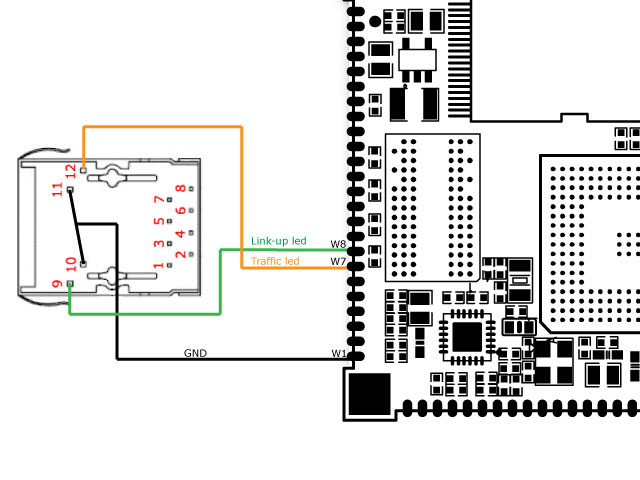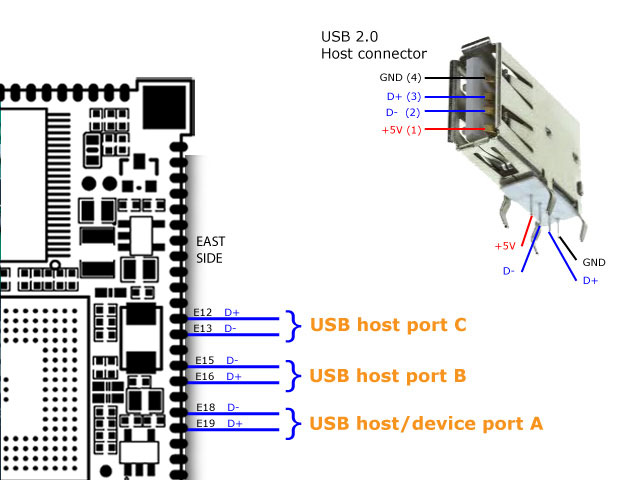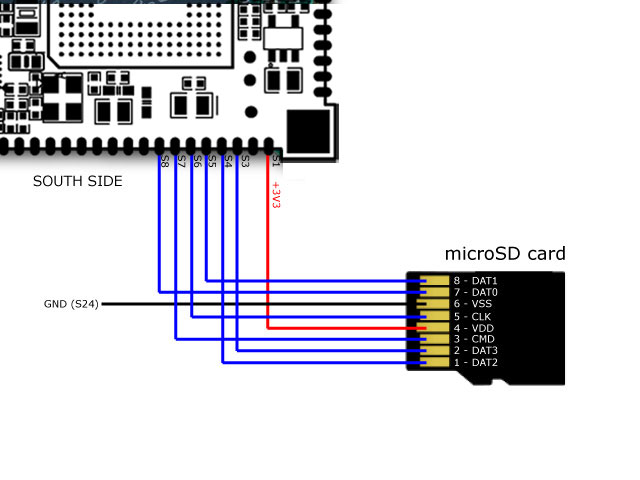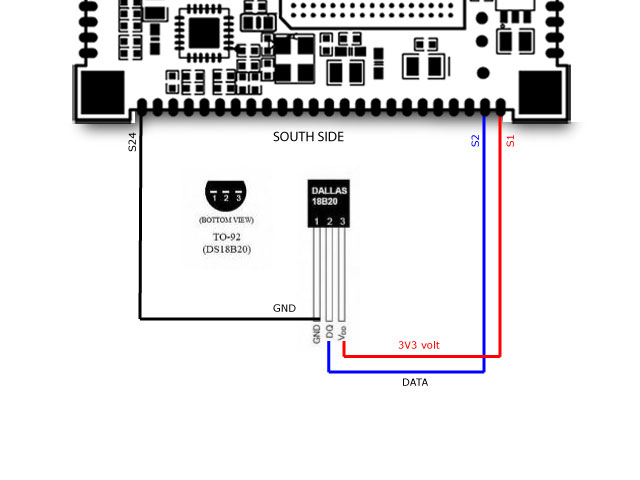Here is a list of examples on how to wire components, power supplies, connectors, sensors, etc to the Aria G25 SoM to create your own Linux embedded board. Click on the image of the device you want to add.








Ethernet
CORE9G25 needs just 5 wires to have a working 10/100 MBit LAN port and a RJ45 ethernet connector (with embedded line tranformers).

These are the lines used:
| Board pins |
Ethernet connector pins |
| W2 (ETH RX+) |
3 (TX+) |
| W3 (ETH RX-) |
6 (TX+) |
| W4 (ETH TX+) |
1 (RX+) |
| W5 (ETH TX-) |
2 (RX-) |
| W6 (ETH 3V3) |
4 (RCT) and 5 (TCT) |
Do not use simple LAN connectors without the embedded line transformers.
Ethernet state leds
Other 3 wires are required to have the link-up and traffic leds working. On this scheme is illustrated how to wire the leds integrated in our LAN connector but it is possible to use also two simple leds (no resistors are required).

These are the lines used:
| pins |
Ethernet connector pins |
| W8 (ETH green link led) |
9 (Green led anode) |
| W7 (ETH yellow traffic led) |
12 (Yellow led anode) |
| W1 (GND) |
10 (Green led cathode) and 11 (Yellow led cathode) |
USB Host
Up to 3 USB 2.0 host ports are available on CORE9G25 module:
- Two hi-speed port at 480 Mbps
- One full speed at 12 Mbps
- One of the hi-speed port can be used as device port.
The pin used are:
| Aria pins |
Port |
Description |
Mode |
| E18 (D-), E19 (D+) |
Port A |
High Speed (480 Mbps) |
Host or Device |
| E15 (D-), E16 (D+) |
Port B |
High Speed (480 Mbps) |
Host |
| E12 (D+), E13 (D-) |
Port C |
Full Speed (12 Mbps) |
Host |
Here is a simple but working scheme.

SD Card
CORE9G25 can load from a SD card all the software it needs.
- To create a bootable memory card follow this article MicroSD card repository
- To buy a ready to use memory card see our eShop.

Lines used:
| Aria pins |
SD card pins |
| S1 (3V3) |
4 (VDD) |
| S3 (DA3) |
1 (DAT3) |
| S4 (DA2) |
9 (DAT2) |
| S5 (DA1) |
8 (DAT1) |
| S6 (CK) |
5 (CLK) |
| S7 (CDA) |
2 (CMD) |
| S8 (DA0) |
7 (DAT0) |
| S24 (GND) |
3 (VSS1) and 6 (VSS2) |
MicroSD memory card
CORE9G25 can load from a microSD card all the software it needs.
- To create a bootable memory card follow this article MicroSD card repository
- To buy a ready to use memory card see our eShop.

Lines used:
| Aria pins |
SD card pins |
| S1 (3V3) |
4 (VDD) |
| S3 (DA3) |
1 (DAT3) |
| S4 (DA2) |
9 (DAT2) |
| S5 (DA1) |
8 (DAT1) |
| S6 (CK) |
5 (CLK) |
| S7 (CDA) |
2 (CMD) |
| S8 (DA0) |
7 (DAT0) |
| S24 (GND) |
3 (VSS1) and 6 (VSS2) |
GPIO examples
Following is a simple example on how to wire a led or a push-button..

We used just two lines in this example but more lines are available and every one is configurable either in input or output mode: see the G25 pinout.
To learn how to drive the led or read the push-button state visit this article: GPIO lines.
All the lines are at 3.3 Volt. Do not connect any 5 Volt logic level signals to avoid damages.
USB webcam
The Microsoft Lifecam HD3000 is a cheap true 720p HD 16:9 hi-res webcam with integrated mic. Removing the plastic shield and usb cable the internal circuitry is just 34x20x6 mm size perfect to be used with the CORE9G25 module.
Using the hi_speed USB port A or B it is possible to stream mjpg video at 1280x720 pixel @ 30fps.
| Aria pins |
HD-3000 |
| E19 (D+) |
Green (D+) |
| E18 (D-) |
White (D-) |
| |
Red (+5V) |
| E17 (GND) |
Black (GND) |


- Video streaming over HTTP
- Time-laps video
1-wire thermal sensor
The DS18B20 digital thermometer provides 9-bit to 12-bit Celsius temperature measurements. It communicates over a 1-Wire bus that by definition requires only one data line (and ground) for communication with a central microprocessor. It has an operating temperature range of -55°C to +125°C and is accurate to ±0.5°C over the range of -10°C to +85°C. (read more...).

Lines used as 1-wire bus:
| Aria pins |
Signals |
| S1 |
3V3 |
| S2 |
1-wire data |
| S24 |
GND |
Debug Serial Port
The debug port is a special serial port used by the RomBOOT firmware burned inside the CPU ROM, the boot loader and the Linux Kernel loaded from the SD memory card to send the systems messages during their execution. The debug port is used also to have a low level access to the Linux system console.
The asyncronous serial signals are available on these pins:
| Aria pins |
Signals |
| S13 |
Debug port TXD |
| S14 |
Debug port RXD |
| S24 |
GND |
This are 3.3 volt level lines so an adapter is required to access them using a PC USB or RS232 serial port and have access to this system console using a terminal emulator.
This scheme shows how to wire the CORE9G25 Debug serial interface but any other 3.3 volt to USB os RS232 serial converter can be used.

Power supply
CORE9G25 needs a single line 3.3 volt DC power supply which can be provided in any combination on the following pins:
| Power lines |
Aria pins |
| +3V3 DC power in |
N1, S1, E24, W24 |
| GND signal ground |
N24, S24, E1, W1 |
RTC backup battery
Applying 3 Volt DC on E1 (GND) and E20 (VBAT +3VDC) it is possible to mantaint the RTC (Real Time Clock) active when the power supply if off. This will mantain the system clock up to 6 months with no power using a small CR1220 Lithium battery.
A bigger battery can be used to extend the time duration.






















